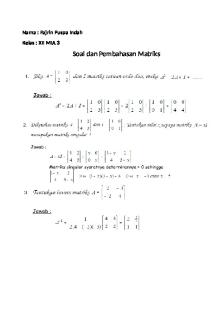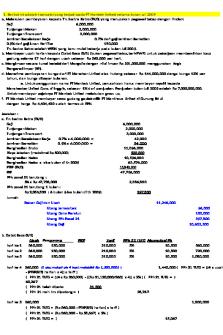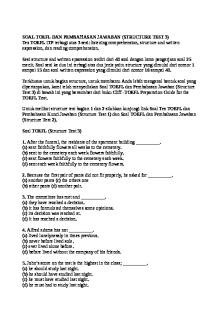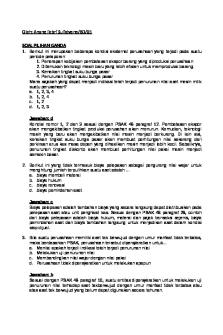Soal dan Pembahasan Termodinamika Teknik Kimia (Vanness Chapter 2) PDF

| Title | Soal dan Pembahasan Termodinamika Teknik Kimia (Vanness Chapter 2) |
|---|---|
| Author | H. (hartoykatoy) |
| Pages | 33 |
| File Size | 398.8 KB |
| File Type | |
| Total Downloads | 349 |
| Total Views | 907 |
Summary
2.1 A non conducting container filled with 25 kg of water at 293.15 K (20°C) is fitted witha stirrer, which is made to turn by gravity acting on a weight of mass 35 kg. The weightfalls slowly through a distance of 5 m in driving the stirrer. Assuming that all work doneon the weight is transferred to...
Description
Accelerat ing t he world's research.
Soal dan Pembahasan Termodinamika Teknik Kimia (Vanness Chapter 2) Hartoyo (hartoykatoy)
Related papers
Download a PDF Pack of t he best relat ed papers
PRARANCANGAN PABRIK KIMIA yolanda E pandiangan
LAMPIRAN A PERHIT UNGAN NERACA MASSA Ganang Set yabudi Pra Desain Pabrik Diet hyl Carbonat e dari CO2 Et hylene Oxide dan Et hanol Melalui Proses Direct Synt he… Yesaya Nat anael
2.1 A non conducting container filled with 25 kg of water at 293.15 K (20°C) is fitted witha stirrer, which is made to turn by gravity acting on a weight of mass 35 kg. The weightfalls slowly through a distance of 5 m in driving the stirrer. Assuming that all work doneon the weight is transferred to the water and that the local acceleration of gravity is 9.8 m/s2, determine: (a) The amount of work done on the water. (b) The internal-energy change of the water. (c) The final temperature of the water, for which Cp= 4.18 kJ kg-' 'C-'. (d) The amount of heat that must be removed from the water to return it to its initial Temperature. (e) The total energy change of the universe because of (1) the process of lowering the weight, (2) the process of cooling the water back to its initial temperature, and (3) both processes together.
Jawab : a. mwt= 35kg g = 9.8 m.s-2 ∆z = 5m (known quantities) Then, we can calculate the work done on water : W
= mwt x g x ∆z
W
= 35kg x 9.8 m.s-2 x 5m
W
= 1715 Joule
W
= 1.715 kJ
b. ∆Utotal = Usaha ∆Utotal = 1,715 kJ c. ∆U = 1.715 kJ Cp = 4.18 kJ/kg.oC dH = dU + d(PV) dH = Cp.dT Cp.dT = dU + d(PV)
P konstan mw.Cp.dT = mw.dU + mw.P.dV Asumsi : Cp dan V konstan, maka,
d. Untuk proses pemulihan kembali ke kondisi awal, perubahan energi dalamnya sama, hanya saja arahnya berbeda sehingga nilai energi dalamnya pun berbeda tanda (dalam hal ini negatif) Q = - ∆Utotal Q = -1,715 kJ e. Perubahan energi dalam sebuah sistem keseluruhan adalah nol (0) ∆(Energy of the system) +∆(Energy of surroundings) = 0 2.2 for an insulated container that changes in temperature along with the water and has a heat capacity equivalent to 5 kg of water. Work the problem with: (a) The water and container as the system
a. Work done on the water: W = mgΔz W = 35 kg x 9,8 m/s2 x 5 m W = 1715 Joule
b. Internal energy change ΔU = W ΔU = 1715 Joule = 1,715 kJ c.
ΔU = mwater+containerCp ΔT 1,715 kJ = 30 kg x 4,18 kJ/kgC x ΔT ΔT = 0,0137 T’ = 20,0137 C
d.
The change ini internal energy is 1715 Joule, so to return it to the initial temperature the heat that must be send out is 1715 Joule too. Q = -ΔU Q = -1715 Joule
e. 0
(b) The water alone as the system.
a. Work done on the water: W = mgΔz W = 35 kg x 9,8 m/s2 x 5 m W = 1715 Joule b. Internal energy change ΔU = W ΔU = 1715 Joule = 1,715 kJ c. ΔU = mwaterCp ΔT + CcontainerΔT 1,715 kJ = 25 kg x 4,18 kJ/kgC x ΔT + 5 kg x4,18 kJ/kgC x ΔT ΔT = 0,0137 T’ = 20,0137 C
d.
The change ini internal energy is 1715 Joule, so to return it to the initial temperature the heat that must be send out is 1715 Joule too. Q = -ΔU Q = -1715 Joule
e.
0
2.3 Sebuah telur berada pada kondisi awal diam, kemudian dijatuhkan di permukaan yang keras dan pecah. Jika telur dianggap sebagai sistem. a. Tanda untuk W ? b. Tanda untuk ΔEp ? c. Tanda untuk ΔEk ? d. Tanda untuk ΔUt ? e. Tanda untuk Q ? Answer : a) W = negatif (-) - W b) ΔEp = negatif (-) - ΔEp c) ΔEk = positif (+) + ΔEk d) ΔUt= bergantung pada nilai Q dan W karena (ΔUt= Q+W) e) Q = positif (+) + Q 2.4 Sebuah motor listrik dengan beban tetap membutuhkan 9,7 ampere pada 110 volt, memberikan 0,93 kW energy mekanik. berapa laju perpindahan panas dari motor dalam kW? Diketahui : I = 9.7 Ampere V = 110 Volt Energi mekanik = 0.93 kW = 930 Watt Berapa panas yang ditransfer oleh motor dalam satuan kW? Penyelesaian : V.I = Energimekanik + panas (Q) Q = V. I – Energimekanik = 9.7 A x 110 V – 930 W = 137 W = 0.137 kW
2.5 One mole of gas in a closed system undergoes a four-step thermodynamic cycle. Use the data given in the following table to determine numerical values for the missing quantities, i.e., "fill in the blanks." Step 12 23 34 41 12341
Jawab: - Step 12 Q12 = ΔU12 – W12 = -200 – (-6000) = 5800 J -
Step 34 ΔU34 =Q34 + W34 = -800 + 200 = -500 J
-
Step 23 Karena ΔU12341 = 0 maka = ΔU12341 - ΔU12 – ΔU34 – ΔU41 U23 = 0 – (-200) – (-500) – 4700 = 200 + 500 – 4700 = -4000 J W23 = ΔU23 – Q23 = -4000 – (-3800) = -200 - Step 41 W12341 = W12 + W23 + W34 + W41 -1400 = -6000 + (-200) + 300 + W41 W41 = 4500 Q41 = ΔU41 – W41 = 4700 – 4500 = 200 Sehingga didapatkan jawaban pada table sbb: Step 12 23 34 41 12341
ΔU’/J -200 -4000 -500 4700 0
Q/J 5800 -3800 -800 200 1400
W/J -6000 -200 300 4500 -1400
ΔU’/J -200 -4000 -500 4700 0
Q/J 5800 -3800 -800 200 1400
W/J -6000 -200 300 4500 -1400
2.6 Pada hukum Termodinamika kesatu berbunyi energy adalah kekal. Makadari itu semua panas yang dibuang dari dalam pendingin harus di pindahkan ke suatu tempat. Dalam kasus pendingin bertenaga listrik, panas di transfer kembali ke ruangan melalui kumparan pada belakang penndingin. Maka, panas yang dibuang dari ruangan di depann pendingin hanya akan dipindahkan ke udara di belakang pendingin. Jawab Pada hukum Termodinamika kedua berbunyi efisiensi hanya sama dengan saatu pada system yang reversible, selain dari itu adalah kurang dari satu. Pendingin mempunyai efisiensi kurang dari satu, yang artinya beberapa panas yang dihasilkan (dalam hal ini pada mesin) hanya untuk melakukan kerja yang dibutuhkan untuk memindahkan panas dari dalam pedingin ke ruangan. Jadi kesimpulannya adalah ruangan akan lebih dingin apabila tidak memakai pendingin.
2.7 Evaluasi : Pada penentuan quadruple point, hanya dibutuhkan satu syarat, yakni antara P (tekanan) atau T (suhu). Jika digunakan suhu 24,1oC , pada suhu tersebut bisa saja memiliki tekanan yang berbeda, tidak 10,2 Mbar. Begitu pula sebaliknya, jika digunakan tekanan 10,2 Mbar, suhu yang ada belum tentu 24,1 o C. Jadi tidak dapat digunakan keduanya. Diketahui : Ditanya : WTurbin = ? Jawab : =
3
;
= 1,571 x 104kg/s
2.8 Sebuah system tertutup tidak bereaksi mengandung spesi 1 dan 2 dalam keseimbnagan uap cair. Spesi 2 adalah gas yang sangat ringan dalam fase liquid/cair. Fasa uap mengandung spesi 1 dan 2, sejumlah mol spesi 2 ditambahkan pada system, yang kemudian dikembalikan keadaanya ke T dan P semula. Sebagai hasil dari proses tersebut, apakah jumlah mol fase cair bertambah berkurang atau tetap?
Jawab :
Berkurang, karena ketika Spesies 2 ditambahkan tidak ada yang menjadi liquid, akan tetapi supaya Tekanan dan Temperatur tetap sama volume uap harus meningkat, maka volume liquid harus berkurang. Liquid tidak perlu melarutkan gas supaya gas berubah menjadi liquid, tidak perlu tercampur, dan sistem akan secara otomatis menurun tekanannya 2.9 A system comprised of chloroform, 1,4-dioxane, and ethanol exists as a two-phase vapor liquid system at 323.15 K (50°C) and 55 kPa. It is found, after the addition of some pure ethanol, that the system can be returned to two-phase equilibrium at the initial T and P. In what respect has the system changed, and in what respect has it not changed? Answer: The number of component in the system: 3 (chloroform, 1,4-dioxane, and ethanol) The number of phase present: 2 Using phase rule to calculate degree of freedom F = 2-π+N ……………………………….. (1) With F = degree of freedom π = number of phase N = number of component By substituting value of π and N into equation (1), we have: F = 2-2+3 F=3 Number of variable that can be changed without changing the number of phase (the degree of freedom) is three variables, namely: pressure, temperature, and composition. Since temperature and pressure are fixed, therefore only one variable left, namely composition. In conclusion, the pressure and temperature don’t change whilst composition is allowed to change.
2.10 A system comprised of chloroform, 1,4-dioxane, and ethanol exists as a twophase vapor liquid system at 323.15 K (50°C) and 55 kPa. It is found, after the addition of some pure ethanol, that the system can be returned to two-phase equilibrium at the initial T and P. (a) How many phase-rule variables in addition to T and P must be chosen so as to fixthe compositions of both phases? (b) If the temperature and pressure are to remain the same, can the overall compositionof the system be changed (by adding or removing material) without affecting thecompositions of the liquid and vapor phases?
answer : a) Phase-rule variables dilihat dari informasi persamaan phase-rule : Jadi , Variable phase-rule : suhu, tekanan, komposisifase. Komposisifase (berupa fraksi mol atau massa) dapat memengaruhi kesetimbangan reaksi antar komponen pada tiap fasenya. b) Saat T &P dibiarkan tetap komposisi system keseluruhan tidak dapat diubah tanpa memengaruhi komposisi cairan&gasnya. Karena komposisi fase merupakan variable phase-rule, dimana saat komposisi keseluruhan berubah, maka kesetimbangan system akan terganggu
2.11
A tank containing 20 kg of water at 293.15 K (20°C) is fitted with a stirrer
that delivers work to the water at the rate of 0.25 kW. How long does it take for the temperature of the water to rise to 303.15 K (30°C) if no heat is lost from the water? For water, Cp= 4.18 k~ kg-' "c-' .
Jawab : Massa = 20 kg Ti = 293.15 K (200C) Tf = 303.15 K (300C) W = 0.25 kW Cp = 4.18 kJ/ kg. 0C = ...... ? W= Q = (20 kg)x(4.18 kJ/ kg. 0C )x(30-20)0C = 836 kJ W=
∆t =
= 3344 s = 0.929 jam
2.12 Panas sejumlah 7,5 kJ ditambahkan pada sistem tertutup, sedangkan energi internalnya berkurang sebanyak12 kJ. Berapa banyak energi yang diubah menjadi kerja ? Untuk proses yang mengakibatkan perubahan keadaan yang sama dengan kerja bernilai 0, berapa jumlah panas yang ditransfer ? answer: Panas ditambahkan = Q = + 7,5 kJ Energi dalam = ΔU = U2 – U1 = -12 kJ Kerja =W a) ΔU = Q+W -12 kJ = 7,5 kJ + W W = -19,5 kJ b) W = 0 ΔU = Q+W -12 Kj = Q + 0 Q = -12 kJ
2.13 Sebuah pengecoran baja seberat 2 kg memiliki suhu awal dari 773,15 K (500 ° C); 40 kg air awalnya di 298,15 K (25 ° C) yang terkandung dalam casting tangki baja yang terisolasi sempurna seberat 5 kg.Pengecoran kemudian direndam dalam air dan system menuju ke ekuilibrium. Berapa suhu akhir jika mengabaikan efek dari ekspansi atau kontraksi, dan menganggap kalor spesifik konstan sebesar 4.18kJkg-1K-1untuk air dan 0.50kJkg -1K-Iuntukbaja. Diketahui : Massa air : 40 Kg Cpair : 4,18 kJ/KgoC Massa tangki : 5 Kg Suhu air dan tangki mula-mula : 25oC Massa logam : 2 Kg Suhu logam mula-mula : 500oC Logam dan tangki berbahan sama dengan Cp = 0,5 kJ/KgoC Ditanya : Suhu akhir campuran Penyelesaian : Asumsi C=Cp=Cv Cara I (Azas Black) Q yang diterima = Q yang dilepaskan Mair.Cpair.∆T1 + Mtangki.Cptangki.∆T2 = Mlogam.Cplogam.∆T2
40Kg.4,18kJ/KgoC.(Tc-25)oC + 5Kg.0,5kJ/KgoC.(Tc-25)oC 2Kg.0,5kJ/KgoC(500-Tc)oC 167,2(Tc-25) + 2,5(Tc-25) = 500 - Tc 169,7(Tc-25) = 500-Tc 170,7Tc = 500 + 4242,5 Tc = 4742,5/170,7 Tc = 27,7827oC Maka suhu akhir campuran adalah 27,7827oC atau 300,9327 K
=
Cara II Mair.∆Uair + Mtangki.∆Utangki+Mlogam.∆Ulogam = 0 Dimana, ∆U =
CpdT =
Tc
Cp(Tc-To)
keterangan : Tc = suhuakhircampuran
To
To = suhumula-mula Maka, persamaan awal menjadi : Mair.Cpair.(Tc-25) + Mtangki.Cptangki.(Tc-25) + Mlogam.Cplogam(Tc-500) = 0 (Mair.Cpair + Mtangki.Cptangki) (Tc-25) = -Mlogam.Cplogam(Tc-500) (40Kg.4,18kJ/KgoC + 5Kg.0,5kJ/KgoC)(Tc-25) = -2Kg.0,5kJ/KgoC.(Tc-500) (167,2+2,5).(Tc-25) = -(Tc-500) 169,7Tc-4242,5 = 500-Tc Tc = 4742,5/1707 oC Tc = 27,7827oC atau 300,9327 K 2.14
An incompressible fluid (p = constant) is contained in an insulated cylinder
fitted with a frictionless piston. Can energy as work be transferred to the fluid? What is the change in internal energy of the fluid when the pressure is increased from PI to P2? Jawab
Incrompessible Fluid
Energi berupa kerja tidak dapat diberikan kepada fluida Karena sifatnya yang incompressible (V dianggap konstan). V konstan berarti W=0
V2
W = - ∫P .dV V1
Saat
P berubah : V konstam dU = dQ + dW dU = dQ + P. dV V konstan = 0 ∆U = Q ∆U = m .C. ∆T
Pada rumus ∆U = m .C. ∆T, perubahan suhu didapatkan dari P.V/T = Konstan P1.V/T1 = P2.V/T2
2.15 Satu kilogram air pada suhu 298,15 K (25oC): (a) Mengalami kenaikan temperatur sebesar 1 K. Berapakah ΔUt, dalam kJ? (b) Mengalami kenaikan ketinggian sebesar Δz. Perubahan energi potensial ΔEp sama dengan ΔUt pada bagian (a). Berapakah Δz, dalam meter? (c) Mengalami percepatan dari diam hingga kecepatan akhir u. Perubahan energi kinetic ΔEk sama dengan ΔUt pada bagian (a). Berapakah u, dalam m/s ? Bandingkan dan diskusikan hasil dari 3 bagian tersebut. Jawab: (a) ΔUt = Q + W m = 1 kg = m.cv. ΔT + 0 = 1. 4180. 1 = 4180 J = 4,18 kJ (b) ΔUt = ΔEp g = 9,8 m/s2 t ΔU = m.g.Δz 4180 = 1. 9,8 . Δz Δz = 4180/9,8 = 426,5306 m (c) ΔUt = ΔEk ΔUt = Ek2 -Ek1 ΔUt = ½ .m. v22 - ½ . m. v12 4180 = ½ . 1. u2 - ½ . 1. 0 u2 = 8360 u = 91,4330 m/s
cv = 4180 J.(kg.K)-1
v2 = u m/s
ΔT = 1 K
v1 = 0 m/s
Berdasarkan ketiga kondisi tersebut, maka untuk mengubah Ut (energi dalam total pada sistem tertutup) sebesar 4,18 kJ dari 1 kg air, dapat dilakukan dengan 3 cara yaitu mengubah suhuya sebesar 1 K atau mengubah ketinggiannya sebesar 426,5306 meter, atau mengubah kecepatannya dari diam menjadi berkecepatan 91,433 m/s.
2.16
Sebuah motor listrik berubah menjadi "panas" di bawah beban yang
seharusnya karena ketidak dapat baliknya (irreversibilitas) internal. Disarankan bahwa kehilangan energi terkait diminimalkan dengan isolasi termal casing bermotor. Berikan komentar kritis pada saran ini. Jawab Panas dari motor listrik terjadi karena ketidak dapat baliknya (irreversibilitas) mekanik dan listrik yang meningkatkan energi internal, hal ini membuat suhu motor meningkat. Suhu akan terus meningkat sampai sistem mencapai kesetimbangan termal dengan lingkungan. Isolasi motor tidak akan menurunkan ketidak dapat baliknya (irreversibilitas) internal dan hanya menyebabkan peningkatan suhu bermotor, yang dapat menyebabkan kerusakan internal. 2.17 Diketahui : 3
;
Ditanya : WTurbin = ? Jawab : =
= 1,571 x 104kg/s
2.18. Liquid water at 453.15 K (180°C) and 1002.7 kPa has an internal energy (on an arbitrary scale) of 762.0 kJ/kg and a specific volume of 1.128 cm3/g , (a) What is its enthalpy? (b) The water is brought to the vapor state at 573.15 K (300°C) and 1500 kPa, where its internal energy is 2784.4 kJ /kg and its specific volume is 169.7 cm3/g. CalculateΔU and ΔH for the process. Jawab Diketahui : U1 = 762.0 kJ/kg P1 = 1002.7 kPa V1 = 1.128 cm3/g = 1.128 · 10-3 m3/kg Ditanya : (a) H1= ? (b) ΔU= ? ΔH= ? Penyelesaian (a) H1 = U1 + (P1 · V1)
U2 = 2784.2 kJ/kg P2 = 1500 kPa V2 = 169.7 cm3/g = 169.7 · 10-3 m3/kg
= 762.0 kJ/kg + (1002.7 kPa· 1.128 · 10-3 m3/kg ) H1 = 763.131 kJ/kg (b) ΔU = U2 – U1 = (2784.2 -762.0) kJ/kg ΔU= 2022.2 kJ/kg ΔH = H2 – H1
→H2 = U2 + (P2 · V2) = 2784.2 k J/kg + (1002.7 kPa· 169.7 · 10-3
m3/kg) = 2954.358 kJ/kg = (2954.358 - 763.131) kJ/kg ΔH = 2191.227 kJ/kg
2.19. A solid body at initial temperature T0is immersed in a bath of water at initial temperature Tw0. Heat is transferred from the solid to the water at a rate Ԛ= K∙(Tw-T), stantaneous values of the where K is a constant and Tw and T are in temperature of the water and solid. Develop an expression for T as a function of time τ. Check your result for the limiting cases, τ = 0 and τ = ∞. Ignore effects of expansion or contraction, and assume constant specific heats for both water and solid. Answer : Ԛ=K (Tw-T)………………………………………. (1) -Ԛ=
………………………………………(2)
Cv= Equation (1) = Equation (2) -K (Tw-T)=m K (Tw-T)=m
Misal : α = Faktor Integral (FI) :e∫-α dt = α (T-Tw) = (FI) α (T-Tw) e∫-α dt = e∫-α dt.α(T-Tw) T. e-α t= e-α t.α (T-Tw) dt T. e-α t = -e-α t (T-Tw)
Saat t = 0 maka T-T0 Saat t = ∞ maka T = -(T-Tw) 2.20.A list of common unit operations follows: (a) Single -pipe heat exchanger; (b) Double -pipe heat exchanger; (c) Pump; (d) Gas compressor: (e)Gas turbine; (f) Throttle valve: (g) Nozzle. Develop
a
simplified
form
of
the
general
steady
balance56e3appropriate for each operation. State carefully, and justify, any assumptions you make.
Answer: First Law of Thermodynamics (Energy Balance)
Dengan, m'i = mass flow rate in. hi = enthalpy of mass in. Vi = Velocity of mass in. Zi = elevation of mass in. m'e = mass flow rate exit. he = enthalpy of mass exit. Ve = Velocity of mass exit. Ze = elevation of mass exit. Q'in= rate of heat transfer W'net = rate of net or shaft work transfer ms = mass of fluid with in system us = specific internal energy of system a = kinetic energy correction factor a = 1 for turbulent flow
-state
energy
a = 0.5 for laminar flow
Open Thermodynamics System
Constant Volume
Constant Pressure
Constant Temp
Isentropic
Politropic
Steady-state System
Energy Balance
Dengan, Sm'i = Sm'e Q' = rate of heat transfer W' = rate of work transfer
a) Single-pipe Heat Exchangers Asumsi :
Perpindahanpanasdianggapsignifikan
Aliranmassahanyasatu Persamaan :
b) Double-pipe Heat Exchangers Asumsi :
Q=0 W=0 Terdapatduaaliranmassa (m'1, m'2)
Persamaan :
c) Pompa Asumsi :
Proses Adiabatiksehinggatidakadapanas, Q= 0
Kerjadianggapsignifikan
Kecepatanalirdiabaikan
Aliranmassahanyasatu(hi = he+ w)
Persamaan :
d) Kompresor Asumsi :
Proses Adiabatiksehinggatidakadapanas, Q= 0
Kerjadianggapsignifikan
Kecepatanalirdiabaikan
Single mass stream (hi = he+ w)
Persamaan :
e) Turbin gas Asumsi :
Proses Adiabatiksehinggatidakadapanas, Q= 0
Kerjadianggapsignifikan
Kecepatanalirdiabaikan
Hanyasatualiranmassa(hi = he+ w)
Persamaan :
f) Throttling Valve Asumsi :
Proses Adiabatiksehinggatidakadapanas, Q= 0
W=0
Kecepatanalirdiabaikan
Q=0
Hanyasatualiranmassa Kecepatanalirdiabaikan
Persamaan :
g) Nozzels Asumsi :
Kecepatanalirdianggapsignifikan
Tidakadaperpindahanpanas, Q = 0
Tidakadaperbedaanketinggian
Kerjadianggaptidaksignifikan, W=0 Aliranmassahanyaterdapatsatu
Persamaan :
Dengan, hes= enthalpy padasaatakhir proses isentropik
2.21.The Reynold number Re is a dimensionless group which characterizes the intensity of a flow. For large Re, a flow is turbulent, for small Re, a flow is laminar. For pipe flow, Re = vρD/µ, where D is pipe diameter and µ is a dynamic ...
Similar Free PDFs

Pembahasan Soal Kinetika Kimia
- 20 Pages

termodinamika teknik
- 58 Pages

Soal dan Pembahasan Matriks
- 21 Pages

Soal Pajak dan pembahasan
- 16 Pages

Pembahasan Soal UN Kimia SMA 2013
- 14 Pages

Soal dan Pembahasan Olimpiade Matematika
- 325 Pages
Popular Institutions
- Tinajero National High School - Annex
- Politeknik Caltex Riau
- Yokohama City University
- SGT University
- University of Al-Qadisiyah
- Divine Word College of Vigan
- Techniek College Rotterdam
- Universidade de Santiago
- Universiti Teknologi MARA Cawangan Johor Kampus Pasir Gudang
- Poltekkes Kemenkes Yogyakarta
- Baguio City National High School
- Colegio san marcos
- preparatoria uno
- Centro de Bachillerato Tecnológico Industrial y de Servicios No. 107
- Dalian Maritime University
- Quang Trung Secondary School
- Colegio Tecnológico en Informática
- Corporación Regional de Educación Superior
- Grupo CEDVA
- Dar Al Uloom University
- Centro de Estudios Preuniversitarios de la Universidad Nacional de Ingeniería
- 上智大学
- Aakash International School, Nuna Majara
- San Felipe Neri Catholic School
- Kang Chiao International School - New Taipei City
- Misamis Occidental National High School
- Institución Educativa Escuela Normal Juan Ladrilleros
- Kolehiyo ng Pantukan
- Batanes State College
- Instituto Continental
- Sekolah Menengah Kejuruan Kesehatan Kaltara (Tarakan)
- Colegio de La Inmaculada Concepcion - Cebu









